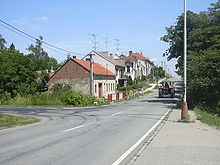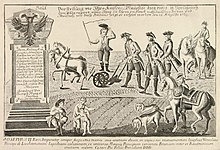Slavíkovice (Rousínov)
| Slavíkovice | ||||
|---|---|---|---|---|
|
||||
| Basic data | ||||
| State : |
|
|||
| Region : | Jihomoravský kraj | |||
| District : | Vyškov | |||
| Municipality : | Rousínov | |||
| Geographic location : | 49 ° 12 ' N , 16 ° 52' E | |||
| Height: | 225 m nm | |||
| Residents : | 665 (March 1, 2001) | |||
| Postal code : | 683 01 | |||
| License plate : | B. | |||
| traffic | ||||
| Street: | D1 : Brno - Vyškov | |||
| Railway connection: | Brno - Přerov | |||
| Next international airport : | Brno Airport | |||
Slavíkovice (German Slawikowitz , also Lakowitz ) is a district of Rousínov in the Czech Republic . It is located one and a half kilometers southwest of Rousínov and belongs to the Okres Vyškov . The village gained fame in the summer of 1769 through the legendary furrow of Emperor Joseph II.
geography
The fishing village Slavíkovice is located on both sides of the Rakovec river at the foot of the westernmost foothills of the Litenčické vrchy in the Vyškovská brázda ( Wischauer Tor ). The Kroužecký Kopec (349 m) rises to the south-east, the Urban (360 m) and the Stará hora (299 m) to the south. The D 1 motorway passes south of the village ; the next exit, 216 Rousínov, is just under a kilometer to the southeast. The Brno - Přerov railway line runs on the northern outskirts, and the Rousínov train station is in Slavíkovice.
Neighboring towns are Vítovice and Kralovopolske Vážany in the north, Rousínov in the Northeast, Rousínovec and Kroužek the east, Letonice , Němčany , Lutršték and Kroužecký Dvur in the southeast, Slavkov u Brna in the south, Velešovice , Holubice and Stará Pošta in the southwest, Tvarožná to the west and Sivice , Kovalovice and Viničné Šumice in the north-west.
history
The first written mention of the place took place in 1237 in connection with a Předbor from Lakowicz. The oldest documentary evidence of the village comes from 1351. At that time, the goods were divided among several landlords. One of them was Wok / Vok I. von Holstein , who belonged to the Church of St. Wenceslaus in Olomouc overwrote an annual interest from his share. Johann von Slawikowitz owned another part. The numerous other owners included Znata von Meilitz, who sold Slawikowitz in 1406 to Marsik von Radowiesicz. He was followed by u. a. from 1437 Mendlik Greifenburg, from 1452 Niklas von Oynitz and from 1491 Wenzel of Piwin which Slawikowicz 1504 in his last will, together with the wild Rezeticz and the Brno suburbs Neustift and Grilwicz to Hynek of Popůvek on Posorschitz bequeathed. After his death in 1528, his daughter Margarethe inherited the property. In 1531 she married Johann von Widbach and four years later in second marriage Oldřich Přepický von Rychmberk , who in 1563 sold the fortress Posorschitz with the villages Posorschitz and Slawikowicz to Niclas von Kokor. A little later Albrecht Černohorský von Boskowitz acquired the property and left it to his brother Jan Šembera in his will in 1571. With his death, the Boskowitz family died out on April 30, 1597 in the male line and in 1604 the property fell to his son-in-law Maximilian I of Liechtenstein . On August 19, 1769, during a breakdown of his court coach, Emperor Joseph plowed on the corridor Díly od Rousínova ( Rausnitzer Feld ) next to the Brno Kaiserstrasse in a field owned by farmer Tranka. Until the middle of the 19th century Slavíkovice always remained subject to Posorschitz and the Prince of Liechtenstein.
After the abolition of patrimonial Slavíkovice formed from 1850 a municipality in the district administration Wischau . With the construction of the railway from Brno to Sternberg by the Moravian-Silesian Northern Railway in 1869, the Rousínov-Slavíkovice station was built on the fields on which the furrows occurred. In 1942 it was incorporated into Rousínov . In 1991 575 people lived in the village. The 2001 census counted 232 houses and 665 residents. The village after Rousínovec is parish .
Slawikowitz furrow
On August 19, 1769, Emperor Joseph II was on his way to the Olschaner camp and Neisse on Brno's Kaiserstraße. Between 5 and 6 p.m., the court coach north of Slawikowitz suffered an axle damage. While the carriage was being repaired, Joseph II got out and went to the field next to the road belonging to farmer Andreas Trnka, where his servant Jan Kartoš was busy plowing. The emperor took the rulers and dug two furrows together with Kartoš, who was in charge of the team.
In the same year Maria Theresa expressed the wish to erect a simple memorial in the field. The landlord, Wenzel von Liechtenstein , had a square column built in 1770. This had fallen into disrepair in 1804 due to the weather and damage to passers-by.
Since 1769 or 1770, next to the column, there was a sandstone block similar to a boundary stone erected by the municipality of Slawikowitz. It broke up in 1788 and was disposed of.
In 1804, the Moravian estates had a sandstone obelisk erected on the site of the column erected by the Prince of Liechtenstein. After the laying of the foundation stone on October 29, 1804, construction came to a standstill due to the Napoleonic War, so that the 17 m high obelisk was not consecrated until 1811. After the monument had already expired in 1832, the estates decided in 1834 to erect a new monument in the form of an artificial casting crowned with the Moravian eagle from the Count Salm's iron foundry in Blansko , which was consecrated in 1836. On November 19, 1920, the monument opposite the Rousínov-Slavíkovice railway station, which had been built in the meantime, was smashed at night and removed in 1921. The relief tablet with the plowing emperor, which was brought to the Moravian State Museum in Brno, was preserved.
After another relief plaque with the plowing emperor was found in Blansko, the town of Rousínov had a replica made of it. This was attached to a large stone and consecrated on November 23, 1995.
The motif of the plowing emperor Joseph is the subject of several graphics, paintings, medals and is depicted on a banknote.
Attractions
- baroque chapel of St. John of Nepomuk, built in 1728
- Memorial stone for the furrows of Emperor Joseph II, erected in 1995 at the Rousínov train station. It is the fifth monument that was erected at this point.
- Pilgrimage chapel of the Seven Sorrows of Mary on Lutršték southeast of the village, built between 1867 and 1877
- Chapel at the source on Lutršték
- Pilgrimage chapel St. Urban, on the Urban, south of the village





